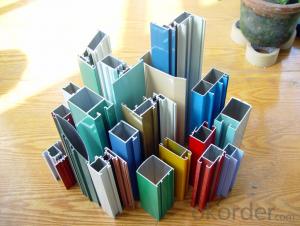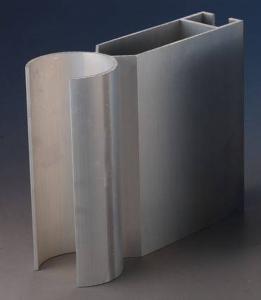Aluminum Windows Profiles Household Step Ladder
OKorder Service Pledge
OKorder Financial Service
You Might Also Like
Lightweight, easy to carry
Alloy: 5xxx and 6xxx
High quality: anticorrosion, rust protection and easy clean surface
Maximum loading capacity: 150kg
Number of steps: 4
Standard package: suitable for long ocean transporting
OEM&ODM is welcome
Last for life time
Specifications
1. Aluminium Ladder
2. Silver Matt Anodizing
3. Reasonable Price
4. Satisfied Service
5. Prompt DeliveryProduct Advantages
1. Plenty of surface treatments for your choice
2. Strict control for surface finish, very little scratch.
3. Accurate mold as well as accurate size.
4. Standard alloy composition aluminium ladder
5. Both ends of the profiles are very plain and with no burr.
- Q: What precautions should be taken while handling aluminum profiles to ensure safety?
- <p>When working with aluminum profiles, it's important to take several safety measures. Always wear appropriate personal protective equipment (PPE), including safety glasses to protect your eyes from flying debris, gloves to protect your hands, and a dust mask to prevent inhalation of dust particles. Ensure that the work area is well-ventilated to avoid inhaling aluminum dust. Use proper tools for cutting and shaping aluminum profiles to minimize the risk of injury. Keep the work area clean and free from clutter to prevent tripping hazards. Be cautious when handling sharp edges and ends of cut aluminum profiles. Lastly, be aware of the weight of the aluminum profiles to avoid back injuries when lifting.</p>
- Q: This question asks about the various applications of aluminum extrusions within the automotive manufacturing industry.
- <p>Aluminum extrusions are widely used in automotive manufacturing due to their lightweight, high strength, and corrosion resistance. They are utilized in several areas: 1) Structural components such as chassis, frames, and body parts to reduce vehicle weight and improve fuel efficiency. 2) Engine components to enhance engine performance and durability. 3) Heat exchangers and radiators for effective cooling systems. 4) Crash management systems to absorb impact during collisions. 5) Interior components like dashboards and door panels for lightweight and aesthetic appeal. 6) Electrical components such as battery casings and wiring harnesses. 7) Wheels and suspension components for improved handling and reduced unsprung weight. These applications contribute to the overall performance, safety, and efficiency of vehicles.</p>
- Q: How do aluminum profiles perform in terms of weather resistance?
- Aluminum profiles are known for their exceptional weather resistance. This is due to the inherent properties of aluminum, such as its corrosion resistance and ability to withstand harsh environmental conditions. Aluminum profiles are typically coated or anodized to further enhance their weather resistance, ensuring long-term durability and protection against various weather elements. Aluminum's corrosion resistance is particularly advantageous in outdoor applications. It forms a natural oxide layer when exposed to oxygen, which acts as a protective barrier against rust and deterioration. This makes aluminum profiles highly resistant to moisture, rain, and humidity, making them suitable for use in coastal areas or regions with high levels of precipitation. Furthermore, aluminum profiles are also resistant to UV radiation. The surface treatment, such as powder coating or anodizing, provides an additional layer of protection against the sun's harsh rays. This prevents the aluminum from fading, chipping, or cracking when exposed to prolonged sunlight, ensuring the profiles retain their original appearance and structural integrity over time. In terms of extreme weather conditions, aluminum profiles are designed to withstand high winds, extreme temperatures, and even severe storms. They have excellent mechanical properties, including high strength and stiffness, which enable them to withstand heavy loads and resist deformation. This makes aluminum profiles ideal for use in construction, architecture, and outdoor infrastructure projects where weather resistance is crucial. Overall, aluminum profiles perform exceptionally well in terms of weather resistance. Their natural corrosion resistance, combined with the various surface treatments available, ensures that they can withstand a wide range of weather conditions without losing their structural integrity or aesthetic appeal.
- Q: Can aluminum profiles be custom-designed?
- Yes, aluminum profiles can be custom-designed according to specific requirements and specifications. Aluminum is a highly versatile and malleable material, making it ideal for customization. Custom-designed aluminum profiles can be created in various shapes, sizes, and configurations to suit the specific needs of different industries and applications. The customization process often involves consulting with experts who have the knowledge and experience to design and manufacture aluminum profiles to meet the desired specifications. Custom-designed aluminum profiles offer the advantage of precise dimensions, unique shapes, and enhanced functionality, ensuring a perfect fit for any project.
- Q: How do aluminum profiles perform in terms of thermal conductivity?
- Aluminum profiles are known for their excellent thermal conductivity. Thermal conductivity refers to the ability of a material to transfer heat. Aluminum has a high thermal conductivity value, which means it can efficiently transfer heat from one point to another. This property makes aluminum profiles highly suitable for applications that require heat dissipation or heat transfer, such as in the construction of heat sinks, radiators, or electrical components. Additionally, the high thermal conductivity of aluminum profiles allows for faster and more efficient cooling, making them ideal for applications that involve thermal management.
- Q: This question asks for methods to ensure the reliable and durable installation of aluminum profiles.
- <p>To ensure the reliable and durable installation of aluminum profiles, follow these steps: Use high-quality aluminum materials that meet industry standards for strength and durability. Ensure proper alignment and level during installation to prevent warping or stress on the profiles. Use appropriate fasteners and adhesives recommended for aluminum to ensure a strong bond. Avoid over-tightening fasteners, which can cause deformation. Regularly inspect and maintain the profiles to check for signs of wear or damage, and address any issues promptly. This will help maintain the integrity and longevity of the aluminum profiles.</p>
- Q: What is aluminum profile?
- Aluminum bars: aluminum bars are obtained by hot extrusion and extrusion so as to obtain aluminum materials of different cross section. The production process of aluminum profile mainly includes three processes: casting, extrusion and coloring. Among them, the color mainly includes: oxidation, electrophoresis coating, fluorine carbon spraying, powder spraying, grain transfer and other processes. Aluminum profile features: 1) corrosion resistance; aluminum profile density is only 2.7g/cm3, about steel, copper or brass density (7.83g/, cm3, 8.93g/, cm3), 1/3. Aluminum can show excellent corrosion resistance in most ambient conditions, including air, water (or brine), petrochemical, and many chemical systems. 2) conductivity; aluminum profile is often chosen because of its excellent electrical conductivity. On the basis of equal weight, the conductivity of aluminum is nearly two times that of copper. 3) thermal conductivity; the thermal conductivity of aluminum alloy is about 50-60% of copper, which is beneficial to the manufacture of heat exchangers, evaporators, heating appliances, cooking utensils, as well as the cylinder head and radiator of automobiles.
- Q: Can aluminum profiles be used for stage and event structures?
- Yes, aluminum profiles can be used for stage and event structures. Aluminum is a lightweight and durable material that is commonly used in the construction industry for various applications, including stage and event structures. Aluminum profiles are versatile and can be easily shaped, cut, and joined together to create custom structures. They offer excellent strength-to-weight ratio, making them suitable for supporting heavy equipment and ensuring the safety of performers and audience members. Additionally, aluminum profiles can be powder-coated or anodized to provide a decorative finish and protect them from corrosion, enhancing the visual appeal and longevity of the structures. Overall, aluminum profiles are a popular choice for stage and event structures due to their versatility, strength, and aesthetic qualities.
- Q: This question asks for a list of various types of adhesives that are typically used in conjunction with aluminum profiles in construction projects.
- <p>Common types of adhesives used with aluminum profiles in construction include epoxy resins, which offer strong bonding and resistance to chemicals and temperature changes; polyurethane adhesives, known for their flexibility and durability; silicone adhesives, which are excellent for sealing and bonding in a wide range of temperatures; acrylic adhesives, valued for their versatility and quick setting times; and cyanoacrylate or 'super glue', which bonds quickly and is great for small, precise applications. Each type has unique properties that make it suitable for different construction needs.</p>
- Q: What are the different types of anodizing options for aluminum profiles?
- Aluminum profiles can be anodized in several ways, each with its own benefits and characteristics. Here are some commonly used types of anodizing: 1. Chromic Acid Anodizing (Type I): This process creates a thin, non-decorative layer that offers excellent corrosion resistance. It is often used as a primer for paints or adhesives. 2. Sulfuric Acid Anodizing (Type II): This is the most widely used anodizing process, resulting in a thicker and more durable oxide layer. It has two subtypes: regular sulfuric anodizing, which provides good corrosion resistance and can be dyed in different colors, and hardcoat anodizing, which produces a very hard and wear-resistant surface suitable for high abrasion applications. 3. Sulfuric Acid Hardcoat Anodizing (Type III): Also known as hard anodizing, this specialized process creates an even thicker and denser oxide layer than regular sulfuric anodizing. It offers enhanced wear and corrosion resistance, making it ideal for harsh environments. 4. Boric-Sulfuric Acid Anodizing (Type IV): This newer process combines sulfuric acid anodizing with a boric acid bath. It produces a thin and hard oxide layer with improved wear resistance and reduced electrical conductivity. 5. Phosphoric Acid Anodizing (Type V): This type of anodizing is used for specific applications that require a thin, dense, and hard oxide layer. It offers good corrosion resistance and can be dyed for aesthetic purposes. These different anodizing options for aluminum profiles provide a range of properties and appearances, making them suitable for various industries such as architecture, automotive, aerospace, electronics, and more. The choice of anodizing type depends on the specific requirements and desired outcome for the aluminum profile.
Send your message to us
Aluminum Windows Profiles Household Step Ladder
OKorder Service Pledge
OKorder Financial Service
Similar products
Hot products
Hot Searches
Related keywords
























